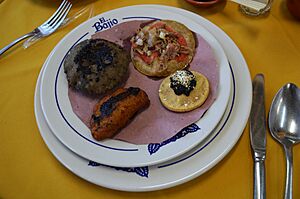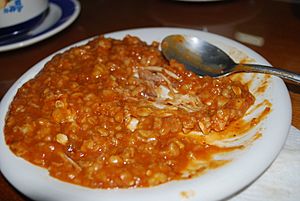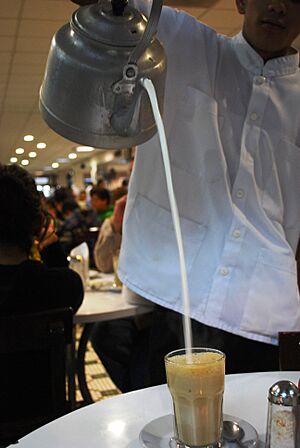Cuisine of Veracruz facts for kids
The cuisine of Veracruz is the special way of cooking food in the Mexican state of Veracruz. This state is located along a big part of Mexico's coast on the Gulf of Mexico. Its food is a mix of three main cultures: the native people, the Spanish, and people from Africa and the Caribbean.
These cultures brought many different ingredients to Veracruz cooking. Some native foods include vanilla, corn, and fresh seafood. The Spanish brought rice, spices, and root vegetables. The mix of these influences changes depending on where you are in the state. Veracruz tries to share its unique food with people both in Mexico and around the world to attract tourists.
Contents
What Makes Veracruz Food Special?
Veracruz cooking gets its special flavor from three main influences: the native people, the Spanish, and people from Africa and the Caribbean.
The biggest native influence comes from the state's long coastline. This means most areas have lots of fresh seafood. Native groups like the Olmecs, Huastecas, and Totonacs used ingredients like vanilla (which comes from the Papantla area) and hoja santa (a special herb). Like other parts of Mexico, their main foods were corn, beans, and squash. They also ate many tropical fruits, chili peppers, tomatoes, and avocados. Today, popular tropical fruits include papaya, mamey sapote, and sapote. These are often used in milkshakes called licuados and ice cream.
The Spanish brought new ingredients like parsley, thyme, marjoram, bay laurel, cilantro, cloves, cinnamon, black pepper, rice, almonds, olives, olive oil, garlic, and capers. They also introduced pineapples and sugar cane from the Caribbean islands. You can see the Spanish influence in how they use olives, olive oil, and capers.
The Afro-Cuban influence came from people brought to Mexico as slaves from Africa and the Caribbean during the time of Spanish rule.
How Influences Mix in Different Areas
The amount of each influence changes across Veracruz. For example, the food in Zongolica is thought to be the most like the original native cooking. Tlacotalpan is known for food that is more Spanish in style.
Veracruz food can also be divided into two main types: coast food and mountain food.
- Coast Food: This food shows the most foreign influence and uses a lot of fish. Dishes like arroz a la tumbada are popular here. It's similar to a Spanish dish called paella.
- Mountain Food: This food uses many different mushrooms, greens, flowers, and corn dishes. In the mountain city of Xalapa, you might find stuffed jalapeño chili peppers, stuffed chipotle peppers, and a stew made with the izote flower. Other dishes include adobo (a type of sauce), red rice, pambazos (sandwiches), and chileatole (a spicy corn drink).
The state is also divided into seven regions based on its geography and people. For example, the Totonac people in the north were influenced by French people who moved there in the 1800s. Food in the south of the state shows influence from the Isthmus of Tehuantepec, where Zapotecs traded goods with the Nahua peoples.
Famous Veracruz Dishes
One of the most famous dishes from Veracruz is Huachinango a la Veracruzana. This means "Snapper Veracruz style." It's a whole fish, usually red snapper, that is baked. It's covered in a tomato sauce with European ingredients like olives, garlic, and capers.
The most common dish in the state is arroz a la tumbada. You can find it in almost all seafood restaurants in Veracruz. It started as a simple dish for fishermen to make their seafood last longer. It usually has different kinds of fish and shellfish, tomatoes, onions, garlic, green chili peppers, and herbs. It's a bit like paella. Another popular dish is caldo de mariscos, a seafood soup.
Mole Xiqueño
Mole Xiqueño is a special sauce named after the city of Xico. Its main ingredients are two types of chili peppers: mulate and ancho. Recipes can vary, but other ingredients often include bananas, peanuts, tortillas, almonds, cashews, breadcrumbs, onions, raisins, garlic, chocolate, sesame seeds, and spices like cinnamon, black pepper, cloves, oregano, and anise. Like other mole sauces, it's usually eaten for special events and holidays. You can now buy the paste to make this sauce from many small businesses.
Mountain Specialties
The mountain areas of Veracruz have more dishes made with corn. Xalapa is famous for its street foods like picaditas and garnachas. These are thick corn cakes often filled with beans.
A very special dish from the mountains is zacahuil. This is like a giant tamale, often several feet long! It can feed between 50 and 150 people. Like other tamales, it's made with corn, flavorings, and meat, then wrapped and cooked. For zacahuil, big leaves from a plant called papatla or banana tree leaves are laid out. A mix of ground corn, lard, chili peppers, and seasonings is spread on the leaves. Pieces of meat, usually pork, are placed on top. The leaves are folded over the filling and tied, then the zacahuil is baked for ten to twelve hours. Unlike most tamales, the filling becomes more like a stew after cooking. This dish is usually served at weddings, religious festivals, and other big events. You can often buy portions in markets, restaurants, and from street vendors.
Other important dishes in Veracruz include chileatole de pollo (chicken stew), crema de palmitos (palm heart cream), and eggs with shrimp. Veracruz also shares a dish with Oaxacan cuisine called huevos con frijoles (scrambled eggs with beans).
Veracruz Coffee
Veracruz is the second biggest producer of coffee in Mexico, after Chiapas. About 153,000 hectares of land are used to grow coffee here. Most coffee growers are small farmers, with about 90,000 in the state. Around 300,000 people are directly involved in making coffee. It's grown in 94 towns, especially in the mountain areas near Xalapa, Coatepec, and Orizaba. The coffee is used for drinking and also to flavor candies and baked goods.
The most famous place to drink coffee in Veracruz is La Gran Parroquia, located in the city of Veracruz. It's known for its strong, espresso-like coffee mixed with hot milk, called café con leche.
Sharing Veracruz Cuisine with the World
The state of Veracruz actively promotes its food both in Mexico and internationally to attract tourists. The capital city, Xalapa, and the nearby city of Boca del Rio are the main centers for food in the state.
The Hotel Fiesta Americana and the Villa Rica Restaurant in the city of Veracruz host an annual event called the Festival de la Cocina Veracruzana (Veracruz Cuisine Festival). This festival focuses on the state's amazing seafood dishes, but also includes beef and chicken. The capital city also has a yearly food festival just for vanilla.
José Burela Picazzo, a chef from Veracruz, has helped share the state's cuisine around the world. In 1995, restaurant owners in Alvarado, Veracruz even set a Guinness World Records title for making the largest arroz a la tumbada ever! It weighed five tons after cooking and fed 10,500 people.
Chef Zarela Martinez has also written books about Veracruz cuisine, including "Zarela's Veracruz."
See also
 In Spanish: Gastronomía de Veracruz para niños
In Spanish: Gastronomía de Veracruz para niños




